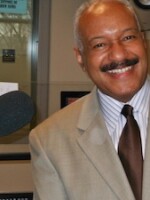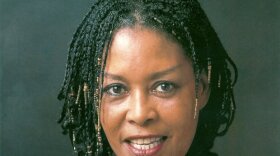On September 7, 1930, Sonny Rollins was born in New York City. Rollins' artistic neighborhood included such musical giants (to-be) as Jackie McLean, drummer Art Taylor and pianist Kenny Drew.
He lived only blocks away from the famous jazz spot The Savoy Ballroom and the world famous Apollo Theater, and only a few doorsteps from a saxophonist soon to become one of his idols, Coleman Hawkins.
Starting on saxophone at the early age of eight after toying with the piano, Rollins released his first recording immediately after graduating from high school in 1947, recording with pianist Bud Powell and singer and bandleader Babs Gonzales. Sonny Rollins became immediately recognized as a tenor voice to be heard but his recording and performing career was briefly interrupted by a ten month stint in Rikers prison after being arrested for armed robbery. It was not long after his release that he recorded with Miles Davis, Horace Silver, Thelonious Monk, Charlie Parker and The Modern Jazz Quartet. By 1954 Rollins had become known not only as a unique strong saxophone voice but a prolific composer having recorded such tunes as Oleo, Doxy and Airegin (Nigeria spelled backwards) all still widely recorded classic even today.
Rollins moved to Chicago in an effort to remove himself from some of the negative (drug) influences in New York. It was in Chicago that he worked with Charlie (Bird) Parker, and by the time he returned to New York he had acquired the nickname “Newk”. As the story is told by Miles Davis, the two were in a cab and the white cab driver thought his passenger (Sonny) was a famous Brooklyn Dogger baseball player Don Newcomb. So Rollins in a very humorous way played along with it for the entire ride thus being called “Newk” by close friends from that point on.
It was during the 1956 – 1959 period that Rollins began playing and recording without a piano player ( to avoid chordal conflicts) and began utilizing heretofore under played time signatures such as ¾ and 6/8 and experimented with calypso rhythms recording the now famous composition “St Thomas”. By 1959 he was being widely proclaimed as the most innovative sound on the Tenor Sax. This period produced such memorable recording as “Saxophone Colossus” with Tommy Flanagan and drummer Max Roach. “Tenor Madness” with the Miles Davis sidemen Red Garland, bassist Paul Chambers and drummer Philly Joe Jones along with John Coltrane (the only time the two would record together). By this time “Newk” had begun working with a piano again and rehearsing regularly with his buddy Ornette Coleman (who stopped using a piano in his ensemble just two years later).
But by early 1960, Rollins withdrew from the music scene altogether in order to “try to perfect my craft,” feeling that he was getting too much praise too soon. It was during this interim period that musicians and fans alike observed him practicing often on the Williamsburg Bridge, in order to prevent his frequent practicing from disturbing his apartment neighbors.
By 1961 Rollins returned to performing, to delight of fans and musicians alike. His return recording was appropriately titled “ The Bridge," which was inducted into the Grammy Hall of Fame in 2015. The album included guitarist Jim Hall, Bassist Bob Cranshaw and drummer Ben Riley. It also was one of Sonny Rollins bestselling albums. It was during this early 60’s thru 1970 period that his thematic soloing became longer and more intense, perhaps more thematic. He worked extensively with such artists Don Cherry , Paul Bley, and Colman Hawkins.
Sonny Rollins began to feel the frustration of the exploitive and often corrupt music business and at the same time became a student of eastern and other spiritual religious practices, often practicing yoga. He remembers, “I’ve always been my own man. I’ve always done, tried to do, what I wanted to do for myself. So these are things I wanted to do. I wanted to go on the Bridge. I wanted to get into religion. But also, the Jazz music business is always bad. It’s never good. So that led me to stop playing in public for a while, again.”
At the encouragement of his wife and manager Lucille, Sonny Rollins returned to recording in the early 1970's, signing with Milestones records and even adopting some funk and R&B rhythms to his performances often using electric bass players and “Funk” drummers. Rollins released over twenty albums that included drummers Jack Dejhonette and Tony Williams, pianist Tommy Flanagan, Stanley Clarke, Ron carter, McCoy Tyner and many others.
Sonny Rollins developed a passion for un-accompanied saxophone solos performing one such solo on NBC’s tonight show. He began turning down nightclub performance and accepting more festival and outdoor arena opportunities. Sonny Rollins also performed (un-credited) on a couple “Rolling Stones” recordings!
Rollins received a Grammy in 2001 “best Jazz Instrumental Album “This Is What I Do,” a 2006 Grammy for Best Instrumental Solo “Why Was I Born,” and a Lifetime achievement Grammy in 2004. Rollins has received several other Grammy nominations, and began recording all of his live recordings in 2000 for gradual release. He has appeared on the Simpsons television show. He holds Honorary Doctorate degrees from over ten different universities.
Respiratory problems have kept Sonny Rollins from playing since 2012.
"I am not finished with what I want to do musically, so I definitely want to do more and I am hoping that I will be able to," Rollins said in a reflective interview on a career spanning more than 65 years.
Rollins voiced confidence that "new, modern medication" would help him return to form. Eager to keep releasing music in the meantime, he has been reaching into his vault of live recordings to put out collections the most recent release in May of 2016.








